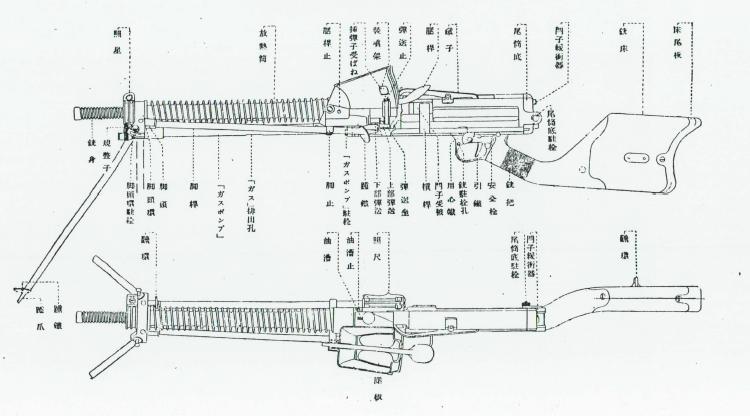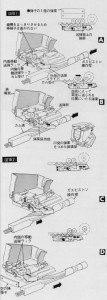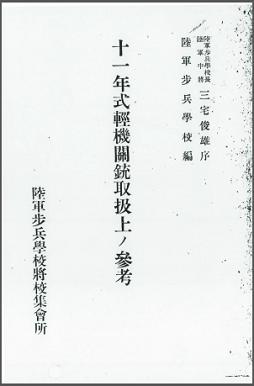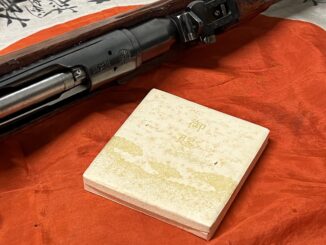Kojiro Nambu, one of Japan’s most prolific arms designers, developed the Type 11 light machine gun as an adaptation of his previous Type 3 HMG design. The Type 11 uses a distinctive hopper feed, and is a better gun than generally believed. Adopted by the Imperial Japanese Army in 1922, it remained in production until 1941.

The Type 11 uses a long stroke gas piston for operation, and the action uses a falling block to lock the bolt for firing. Angled camming projections in the sides of the receiver slide the locking piece down to lock and up to open when the bolt cycles. The bolt moves linearly back and forth with no special early leverage to aid extraction – a type of design which often has difficulties in field conditions. To ameliorate this potential problem, the Type 11 has an automatic oiler system to lubricate the cartridges prior to chambering. While fine in normal range conditions, oiled cartridges tend to attract dust and dirt, leading to another source of jamming problems on the battlefield.
The trigger mechanism of the Type 11 was a simple one, and the gun fired in full-automatic only from an open bolt.
The most unique element of the Type 11 is its hopper feed system. The gun is fed by standard 5-round stripper clips that were used by riflemen (specifically the, 6.5x50mm cartridges used by the Type 38 bolt action rifle). A hopper on the left side of the receiver held six clips, and had series of mechanical teeth activated by a cam track on the gas piston to pull cartridges off each clip and into the action. When the fifth round was fed, the clip would fall empty out the bottom of the hopper and the next full clip would drop into place for feeding. A spring loaded follower held pressure on top of the clips in the hopper, which could be refilled constantly during firing. You can see a diagram here of the feed mechanism (click to enlarge):

The hopper on the receiver also necessitated the sights being offset to the right of the bore. To compensate for this, the buttstock is also dog-legged off to the right of the gun. This is not always clear in photographs, but very obvious when handling the gun.
In theory, the hopper system shows a number of benefits. It offers easy logistics by allowing the riflemen and machine gunners to use identical ammunition supplies, and in theory allows the gun to fire indefinitely without breaks for changing magazines. In practice, however, the system required two men to run efficiently, and could not be easily reloaded on the move. A tripod was produced for use with the Type 11 as well, but appears to have been rare in actual use. Being fed from 5-round clips and without a quick-change barrel, the Type 11 was note really suited for sustained fire.
Captured Type 11 Nambus garnered some interest in Russian military circles in the 1930s, and an experimental variant of the DP28 light machine gun was manufactured using the same hopper feed system. We have several photographs of this gun on the Kubynov LMG page in the Vault. The Russians readily saw the inherent problems of the idea, and it never progressed past prototype stage.
There are also some long-lived misconceptions surrounding the Type 11. It is often written that the gun was unreliable and required a reduced-pressure cartridge to function. This is basic on a grain of truth, but misunderstood. The Type 11, when clean, is a very smooth and pleasant gun to shoot, and quite reliable. It also is designed with an adjustable gas regular to allow the use of a variety of ammunition pressure. However, it was determined that the relatively short barrel (17.5 inches) produced excessive flash with standard ammunition (initially intended for Type 38 rifles with barrel more tha foot longer). A new loading was introduced for this reason, which had a slightly lower velocity (under 100fps), but burned much more completely in the Type 11 short barrel and produced much less flash as a result.
We have a copy of an original Japanese manual for the Type 11, which you can download below or from the Type 11 Nambu LMG page in the Vault. The manual includes many diagrams of Type 11 parts and subassemblies as well as the tripod, although the text is in Japanese characters.




Diagrams are interesting indeed!
Excellent Post. Thanks.
It would be also nice Ian if you post Type 100 japanese submachine gun manual,there is virtualy 0 information on it..
Interesting indeed!
“A new loading was introduced for this reason, which had a slightly lower velocity (under 100fps), but burned much more completely in the Type 11 short barrel and produced much less flash as a result.”
…
Thereby completely negating the logistical advantage of using the same stripper clips as the rifles. Great going guys.
I seem to recall that Japanese sniper rifles used a reduced propellant load to mitigate muzzle flash. Was this the same load?
I believe is was the same reduced load. My understanding is that it was not uncommonly used by riflemen as well. And the Type 11 would function with the initial type of standard ball, just with more blast and flash. So logistically, it wasn’t necessarily a big problem.